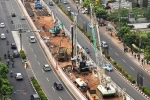KAI cuts 140 long-distance railway trips as of 1 June
This article has been translated by PwC Indonesia as part of our Indonesia Infrastructure News Service. PwC Indonesia has not checked the accuracy of, and accepts no responsibility for the content.
Investor Daily - KAI pangkas 140 perjalanan KA jarak jauh per 1 Juni
12 May 2023
By: Amrozi Amenan
Jakarta - PT Kereta Api Indonesia (Persero) or KAI will cut the travel time of 140 long-distance railway trips as of 1 June 2023. The travel time reduction includes executive railways, business railways, and economy railways that serve various routes, such as Jakarta-Surabaya (round trip), Jakarta-Solo (round trip), Bandung-Surabaya (round trip), and others.
“The acceleration of railway travel time is a form of KAI’s service improvement for customers. With faster travel time, the people’s mobility will increase through railway transportation,” KAI Public Relations VP Joni Martinus said in his statement on Thursday (11/5/2023).
The travel time of railways vary. For some, the travel time is cut by up to 78 minutes, such as for the Gambir-Cilacap route that currently takes 6 hours 5 minutes from previously 7 hours 23 minutes.
“With shorter travel time, customers can utilise the time for other activities as travelling is now more efficient,” Joni said.
Besides Purwojaya Train, there is Mutiara Selatan (85) Train that serves the Surabaya Gubeng-Bandung route. Travel time previously took 12 hours 15 minutes, but now it only takes 11 hours 3 minutes (72 minutes faster). Mutiara Selatan (86) Train that serves the Bandung-Surabaya route previously took 12 hours 15 minutes, but now it only takes 11 hours 8 minutes (67 minutes faster).
Mataram (90) Train that serves the Pasarsenen-Solo Balapan route previously took 9 hours 6 minutes, but now it only takes 7 hours 59 minutes (67 minutes faster). Mataram (89) Train that serves the Solo Balapan-Pasarsenen route previously took 9 hours 18 minutes, but now it only takes 8 hours 12 minutes (66 minutes faster). Bima (60) Train that serves the Gambir-Surabaya Gubeng route previously took 11 hours 31 minutes, but now it only takes 10 hours 30 minutes (61 minutes faster). Lodaya (93) Train that serves that Solo Balapan-Bandung route previously took 8 hours 59 minutes, but now it only takes 8 hours 0 minutes (59 minutes faster).
Bima (59) Train that serves the Surabaya Gubeng-Gambir route previously took 11 hours 35 minutes, but now it only takes 10 hours 40 minutes (55 minutes faster). Fajar Utama Solo (88) Train that serves the Pasarsenen-Solo Balapan route previously took 8 hours 34 minutes, but now it only takes 7 hours 40 minutes (54 minutes faster). Lodaya (91) Train that serves that Solo Balapan-Bandung route previously took 8 hours 50 minutes, but now it only takes 8 hours 0 minutes (50 minutes faster).
Joni said that the travel time acceleration could be achieved through several infrastructure improvement steps by KAI and Railways Directorate General of the Transportation Ministry. Such as the double track on Gedebade-Haurpugur, the operation of the double-double track on Cakung-Bekasi, the infrastructure speed increase on various routes to up to 120 km/hour, the signalling system revision, and the operation of BH1120 on Bumiayu-Linggapura route.
“KAI will continuously improve its services through various innovations, such as the travel time acceleration of long-distance railways. We hope that the people will continue to use railways as their mainstay transportation,” Joni said.
He added that the acceleration of railway travel time coincided with the implementation of the 2023 train trip chart (Gapeka) that would be effective on 1 June 2023 to replace the 2021 Gapeka that has been used by KAI since 2021. According to him, Gapeka is a guideline for railway trips that is illustrated in the form of lines. The lines show the stations, time, distance, speed, and position of the railway from its departures, stops, arrivals, crossings, and passings. The purpose of the lines in Gapeka is to control all railway trips, such as their departure schedule, travel time, and maintenance schedule.
Joni explained that the implementation of 2023 Gapeka would accelerate travel time.
“One of the benefits that can be enjoyed by customers from 2023 Gapeka is the efficiency of the railway trips,” Joni said.
Furthermore, he explained that the travel time of railway trips became more efficient as they now only take a total of 2,727 minutes per day.
“The time is reduced by 335 minutes for argo railways, 406 minutes for executive railways, 1,433 [minutes] for mixed executive railways, and 55 minutes for economy railways,” he said.
KAI stated that potential passengers must pay attention to their trip schedule. The travel time of almost all long-distance railways will be accelerated as of 1 June 2023 thanks to the 2023 Gapeka, which will impact the departure schedules of the railways.
“The people who want to use railways that depart after 1 June 2023 need to pay attention to their schedule on their ticket so that they are not left behind. We hope that the implementation of the 2023 Gapeka will increase the number of passengers through the improvement of services, such as shorter travel time, additional railway trips, and others,” Joni explained.


















